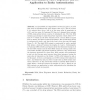Free Online Productivity Tools
i2Speak
i2Symbol
i2OCR
iTex2Img
iWeb2Print
iWeb2Shot
i2Type
iPdf2Split
iPdf2Merge
i2Bopomofo
i2Arabic
i2Style
i2Image
i2PDF
iLatex2Rtf
Sci2ools
PKC
2005
Springer
2005
Springer
RSA with Balanced Short Exponents and Its Application to Entity Authentication
In typical RSA, it is impossible to create a key pair (e, d) such that both are simultaneously much shorter than φ(N). This is because if d is selected first, then e will be of the same order of magnitude as φ(N), and vice versa. At Asiacrypt’99, Sun et al. designed three variants of RSA using prime factors p and q of unbalanced size. The first RSA variant is an attempt to make the private exponent d short below N0.25 and N0.292 which are the lower bounds of d for a secure RSA as argued first by Wiener and then by Boneh and Durfee. The second RSA variant is constructed in such a way that both d and e have the same bit-length 1 2 log2 N + 56. The third RSA variant is constructed by such a method that allows a trade-off between the lengths of d and e. Unfortunately, at Asiacrypt’2000, Durfee and Nguyen broke the illustrated instances of the first RSA variant and the third RSA variant by solving small roots to trivariate modular polynomial equations. Moreover, they showed that ...
| Added | 28 Jun 2010 |
| Updated | 28 Jun 2010 |
| Type | Conference |
| Year | 2005 |
| Where | PKC |
| Authors | Hung-Min Sun, Cheng-Ta Yang |
Comments (0)

